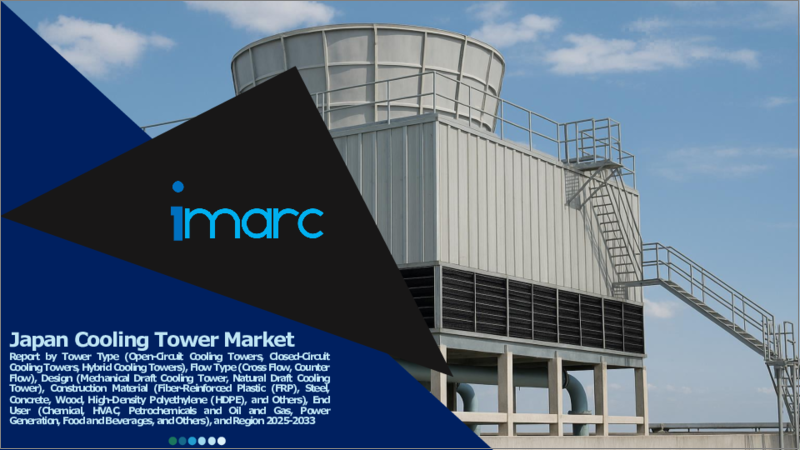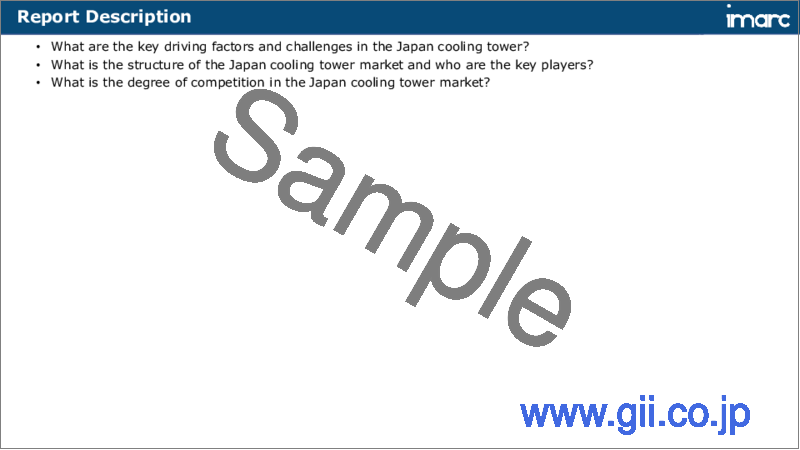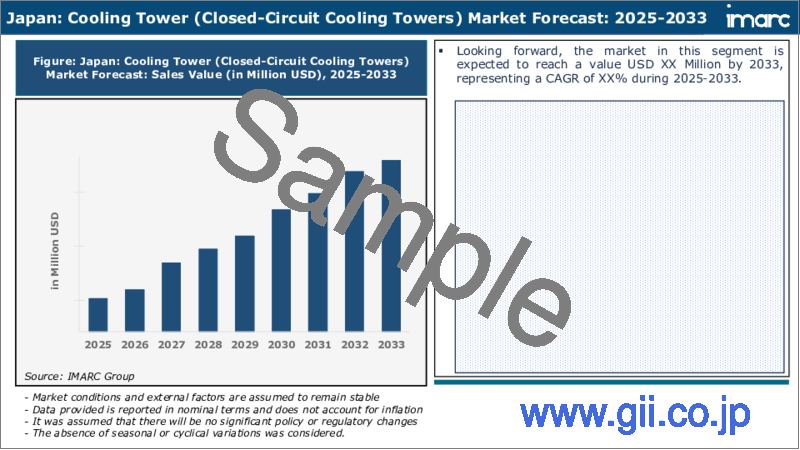|
|
市場調査レポート
商品コード
1746528
日本の冷却塔市場レポート:塔タイプ、フロータイプ、設計、建設資材、エンドユーザー、地域別、2025~2033年Japan Cooling Tower Market Report by Tower Type, Flow Type, Design, Construction Material (Fiber-Reinforced Plastic, Steel, Concrete, Wood, High-Density Polyethylene, and Others), End User, and Region 2025-2033 |
||||||
カスタマイズ可能
|
|||||||
| 日本の冷却塔市場レポート:塔タイプ、フロータイプ、設計、建設資材、エンドユーザー、地域別、2025~2033年 |
|
出版日: 2025年06月02日
発行: IMARC
ページ情報: 英文 116 Pages
納期: 5~7営業日
|
全表示
- 概要
- 目次
日本の冷却塔市場規模は2024年に1億8,420万米ドルに達しました。今後、IMARC Groupは、市場は2033年までに2億6,430万米ドルに達し、2025~2033年にかけて3.89%の成長率(CAGR)を示すと予測しています。発電、石油化学、HVAC、製造業など、機器やプロセスの温度を維持するために効率的な冷却ソリューションを必要とする数多くの産業の成長が、主に市場を牽引しています。
本レポートで扱う主要質問
- 日本の冷却塔市場はこれまでどのように推移し、今後どのように推移するのか?
- COVID-19が日本の冷却塔市場に与えた影響は?
- 日本の冷却塔市場の塔タイプ別区分は?
- 日本の冷却塔市場のフロータイプ別区分は?
- 日本の冷却塔市場のデザイン別区分は?
- 日本の冷却塔市場の建設資材別区分は?
- 日本の冷却塔市場のエンドユーザー別区分は?
- 日本の冷却塔市場のバリューチェーンにおける各段階とは?
- 日本の冷却塔の主要な促進要因と課題は何か?
- 日本の冷却塔市場の構造と主要参入企業は?
- 日本の冷却塔市場における競合の程度は?
目次
第1章 序文
第2章 調査範囲と調査手法
- 調査の目的
- ステークホルダー
- データソース
- 市場推定
- 調査手法
第3章 エグゼクティブサマリー
第4章 日本の冷却塔市場-イントロダクション
- 概要
- 市場力学
- 産業動向
- 競合情報
第5章 日本の冷却塔市場情勢
- 過去と現在の市場動向(2019~2024年)
- 市場予測(2025~2033年)
第6章 日本の冷却塔市場-塔タイプ別内訳
- 開放型冷却塔
- 閉回路冷却塔
- ハイブリッド冷却塔
第7章 日本の冷却塔市場-フロータイプ別内訳
- クロスフロー
- カウンターフロー
第8章 日本の冷却塔市場-設計別内訳
- 機械ドラフト冷却塔
- 自然ドラフト冷却塔
第9章 日本の冷却塔市場-建設資材別内訳
- 繊維強化プラスチック(FRP)
- 鋼鉄
- コンクリート
- 木材
- 高密度ポリエチレン(HDPE)
- その他
第10章 日本の冷却塔市場-エンドユーザー別内訳
- 化学品
- 空調
- 石油化学製品と石油・ガス
- 発電
- 飲食品
- その他
第11章 日本の冷却塔市場-競合情勢
- 概要
- 市場構造
- 市場企業のポジショニング
- 主要成功戦略
- 競合ダッシュボード
- 企業評価象限
第12章 主要企業のプロファイル
第13章 日本の冷却塔市場-産業分析
- 促進要因・抑制要因・機会
- ポーターのファイブフォース分析
- バリューチェーン分析
第14章 付録
Japan cooling tower market size reached USD 184.2 Million in 2024. Looking forward, IMARC Group expects the market to reach USD 264.3 Million by 2033, exhibiting a growth rate (CAGR) of 3.89% during 2025-2033. The increasing growth of numerous industries, such as power generation, petrochemicals, HVAC, and manufacturing, which require efficient cooling solutions to maintain equipment and process temperatures, is primarily driving the market.
A cooling tower is a crucial industrial device designed to dissipate excess heat from various processes, such as power generation, manufacturing, and HVAC systems. It operates on the principle of evaporative cooling, efficiently removing heat from water or other cooling fluids. Inside a cooling tower, hot water is pumped to the top, where it is evenly distributed over a fill material, often consisting of plastic or wood. As the water flows over the fill, it is exposed to a stream of ambient air, causing some of it to evaporate. This evaporation process absorbs heat from the remaining water, cooling it significantly. The cooled water then collects at the bottom of the tower and is recirculated through the industrial process, repeating the cycle. Cooling towers are vital for maintaining the optimal operating temperatures of machinery and systems, enhancing their efficiency and longevity. They help industries save energy and reduce environmental impact by facilitating heat exchange with the atmosphere, ultimately releasing cooler water back into the environment.
Japan Cooling Tower Market Trends:
The cooling tower market in Japan is experiencing robust growth, primarily driven by several key factors. Firstly, the rising regional demand for electricity has propelled the expansion of power generation facilities, including thermal power plants, where cooling towers play a pivotal role in dissipating excess heat. Additionally, stringent environmental regulations aimed at curbing water wastage and minimizing heat pollution have spurred the adoption of more efficient and eco-friendly cooling tower technologies. Furthermore, the industrial sector's burgeoning need for process cooling in manufacturing and petrochemical industries has fueled market growth. This surge in industrial activities is closely linked to the expanding manufacturing sector and the development of mega-infrastructure projects. Moreover, the increasing awareness of energy conservation and sustainability is driving the demand for advanced cooling tower solutions that enhance energy efficiency and reduce operational costs. Furthermore, the growth of the data center industry, with its voracious appetite for cooling solutions, is expected to drive the cooling tower market in Japan during the forecast period.
Japan Cooling Tower Market Segmentation:
Tower Type Insights:
- Open-Circuit Cooling Towers
- Closed-Circuit Cooling Towers
- Hybrid Cooling Towers
Flow Type Insights:
- Cross Flow
- Counter Flow
Design Insights:
- Mechanical Draft Cooling Tower
- Natural Draft Cooling Tower
Construction Material Insights:
- Fiber-Reinforced Plastic (FRP)
- Steel
- Concrete
- Wood
- High-Density Polyethylene (HDPE)
- Others
End User Insights:
- Chemical
- HVAC
- Petrochemicals and Oil and Gas
- Power Generation
- Food and Beverages
- Others
Competitive Landscape:
The market research report has also provided a comprehensive analysis of the competitive landscape in the market. Competitive analysis such as market structure, key player positioning, top winning strategies, competitive dashboard, and company evaluation quadrant has been covered in the report. Also, detailed profiles of all major companies have been provided.
Key Questions Answered in This Report:
- How has the Japan cooling tower market performed so far and how will it perform in the coming years?
- What has been the impact of COVID-19 on the Japan cooling tower market?
- What is the breakup of the Japan cooling tower market on the basis of tower type?
- What is the breakup of the Japan cooling tower market on the basis of flow type?
- What is the breakup of the Japan cooling tower market on the basis of design?
- What is the breakup of the Japan cooling tower market on the basis of construction material?
- What is the breakup of the Japan cooling tower market on the basis of end user?
- What are the various stages in the value chain of the Japan cooling tower market?
- What are the key driving factors and challenges in the Japan cooling tower?
- What is the structure of the Japan cooling tower market and who are the key players?
- What is the degree of competition in the Japan cooling tower market?
Table of Contents
1 Preface
2 Scope and Methodology
- 2.1 Objectives of the Study
- 2.2 Stakeholders
- 2.3 Data Sources
- 2.3.1 Primary Sources
- 2.3.2 Secondary Sources
- 2.4 Market Estimation
- 2.4.1 Bottom-Up Approach
- 2.4.2 Top-Down Approach
- 2.5 Forecasting Methodology
3 Executive Summary
4 Japan Cooling Tower Market - Introduction
- 4.1 Overview
- 4.2 Market Dynamics
- 4.3 Industry Trends
- 4.4 Competitive Intelligence
5 Japan Cooling Tower Market Landscape
- 5.1 Historical and Current Market Trends (2019-2024)
- 5.2 Market Forecast (2025-2033)
6 Japan Cooling Tower Market - Breakup by Tower Type
- 6.1 Open-Circuit Cooling Towers
- 6.1.1 Overview
- 6.1.2 Historical and Current Market Trends (2019-2024)
- 6.1.3 Market Forecast (2025-2033)
- 6.2 Closed-Circuit Cooling Towers
- 6.2.1 Overview
- 6.2.2 Historical and Current Market Trends (2019-2024)
- 6.2.3 Market Forecast (2025-2033)
- 6.3 Hybrid Cooling Towers
- 6.3.1 Overview
- 6.3.2 Historical and Current Market Trends (2019-2024)
- 6.3.3 Market Forecast (2025-2033)
7 Japan Cooling Tower Market - Breakup by Flow Type
- 7.1 Cross Flow
- 7.1.1 Overview
- 7.1.2 Historical and Current Market Trends (2019-2024)
- 7.1.3 Market Forecast (2025-2033)
- 7.2 Counter Flow
- 7.2.1 Overview
- 7.2.2 Historical and Current Market Trends (2019-2024)
- 7.2.3 Market Forecast (2025-2033)
8 Japan Cooling Tower Market - Breakup by Design
- 8.1 Mechanical Draft Cooling Tower
- 8.1.1 Overview
- 8.1.2 Historical and Current Market Trends (2019-2024)
- 8.1.3 Market Forecast (2025-2033)
- 8.2 Natural Draft Cooling Tower
- 8.2.1 Overview
- 8.2.2 Historical and Current Market Trends (2019-2024)
- 8.2.3 Market Forecast (2025-2033)
9 Japan Cooling Tower Market - Breakup by Construction Material
- 9.1 Fiber-Reinforced Plastic (FRP)
- 9.1.1 Overview
- 9.1.2 Historical and Current Market Trends (2019-2024)
- 9.1.3 Market Forecast (2025-2033)
- 9.2 Steel
- 9.2.1 Overview
- 9.2.2 Historical and Current Market Trends (2019-2024)
- 9.2.3 Market Forecast (2025-2033)
- 9.3 Concrete
- 9.3.1 Overview
- 9.3.2 Historical and Current Market Trends (2019-2024)
- 9.3.3 Market Forecast (2025-2033)
- 9.4 Wood
- 9.4.1 Overview
- 9.4.2 Historical and Current Market Trends (2019-2024)
- 9.4.3 Market Forecast (2025-2033)
- 9.5 High-Density Polyethylene (HDPE)
- 9.5.1 Overview
- 9.5.2 Historical and Current Market Trends (2019-2024)
- 9.5.3 Market Forecast (2025-2033)
- 9.6 Others
- 9.6.1 Historical and Current Market Trends (2019-2024)
- 9.6.2 Market Forecast (2025-2033)
10 Japan Cooling Tower Market - Breakup by End User
- 10.1 Chemical
- 10.1.1 Overview
- 10.1.2 Historical and Current Market Trends (2019-2024)
- 10.1.3 Market Forecast (2025-2033)
- 10.2 HVAC
- 10.2.1 Overview
- 10.2.2 Historical and Current Market Trends (2019-2024)
- 10.2.3 Market Forecast (2025-2033)
- 10.3 Petrochemicals and Oil and Gas
- 10.3.1 Overview
- 10.3.2 Historical and Current Market Trends (2019-2024)
- 10.3.3 Market Forecast (2025-2033)
- 10.4 Power Generation
- 10.4.1 Overview
- 10.4.2 Historical and Current Market Trends (2019-2024)
- 10.4.3 Market Forecast (2025-2033)
- 10.5 Food and Beverages
- 10.5.1 Overview
- 10.5.2 Historical and Current Market Trends (2019-2024)
- 10.5.3 Market Forecast (2025-2033)
- 10.6 Others
- 10.6.1 Historical and Current Market Trends (2019-2024)
- 10.6.2 Market Forecast (2025-2033)
11 Japan Cooling Tower Market - Competitive Landscape
- 11.1 Overview
- 11.2 Market Structure
- 11.3 Market Player Positioning
- 11.4 Top Winning Strategies
- 11.5 Competitive Dashboard
- 11.6 Company Evaluation Quadrant
12 Profiles of Key Players
- 12.1 Company A
- 12.1.1 Business Overview
- 12.1.2 Product Portfolio
- 12.1.3 Business Strategies
- 12.1.4 SWOT Analysis
- 12.1.5 Major News and Events
- 12.2 Company B
- 12.2.1 Business Overview
- 12.2.2 Product Portfolio
- 12.2.3 Business Strategies
- 12.2.4 SWOT Analysis
- 12.2.5 Major News and Events
- 12.3 Company C
- 12.3.1 Business Overview
- 12.3.2 Product Portfolio
- 12.3.3 Business Strategies
- 12.3.4 SWOT Analysis
- 12.3.5 Major News and Events
- 12.4 Company D
- 12.4.1 Business Overview
- 12.4.2 Product Portfolio
- 12.4.3 Business Strategies
- 12.4.4 SWOT Analysis
- 12.4.5 Major News and Events
- 12.5 Company E
- 12.5.1 Business Overview
- 12.5.2 Product Portfolio
- 12.5.3 Business Strategies
- 12.5.4 SWOT Analysis
- 12.5.5 Major News and Events
13 Japan Cooling Tower Market - Industry Analysis
- 13.1 Drivers, Restraints, and Opportunities
- 13.1.1 Overview
- 13.1.2 Drivers
- 13.1.3 Restraints
- 13.1.4 Opportunities
- 13.2 Porters Five Forces Analysis
- 13.2.1 Overview
- 13.2.2 Bargaining Power of Buyers
- 13.2.3 Bargaining Power of Suppliers
- 13.2.4 Degree of Competition
- 13.2.5 Threat of New Entrants
- 13.2.6 Threat of Substitutes
- 13.3 Value Chain Analysis






